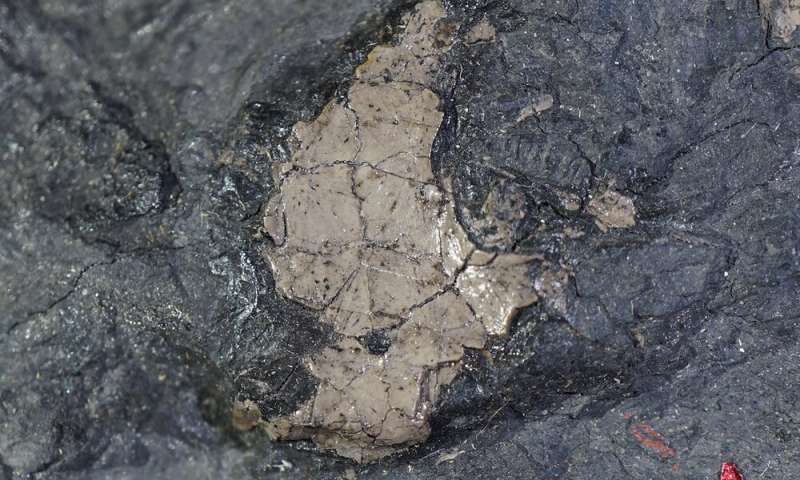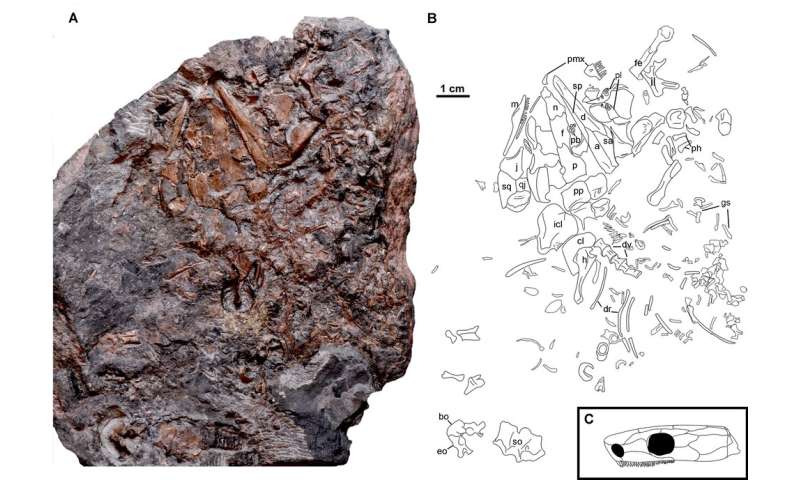A fossil discovery reveals the earliest relative of modern mammals
Over 300 million years ago, our ancestors diverged from the ancestors of reptiles and began the evolutionary journey towards becoming mammals.
What were these earliest ancestors like? For one, they looked nothing like modern mammals. The group known as synapsids—described as "mammal-like reptiles"—looked much more like reptiles but could be distinguished by a single large opening in the cheek, likely for jaw muscles. Synapsids slowly ascended to the top of the food chain, but we still know very little about the first 10 million years of synapsid evolution.
As Ph.D. candidates in paleontology, we were all working on different aspects of early tetrapod—four-footed animals—evolution. The three of us led a diverse research team that revisited some fossils which had been described as an early reptile named Asaphestera, collected in Nova Scotia. Our study led to a number of surprising results, the most significant of which is our identification of Asaphestera as the earliest definitive synapsid fossil.
Joggins, a UNESCO World Heritage site
Originally named Chegoggin by the Mi'kmaq people, the fossil cliffs at Joggins, N.S., preserve the remains of a vast fossil forest that—318 million years ago—would have been situated at the equator. Among the fossilized tree stumps and trunks, many of which are preserved in upright positions, is one of the richest fossil records of early tetrapods.

The significance of these expansive fossil beds was recognized centuries ago by some of the leading geologists and paleontologists of the 19th century, when Darwin's theory of evolution was revolutionizing the field of biology. It was at the Joggins Fossil Cliffs that geologist Charles Lyell developed his foundational theory regarding the formation of coal and where Lyell and geologist Sir John William Dawson discovered what were, at the time, the earliest known fossils of land animals.
These animal fossils have since been periodically revisited, first by Irish paleontologist Margaret Steen in the 1920s and later by Canadian paleontologist Bob L. Carroll, the father of Canadian vertebrate paleontology and longtime professor at McGill University.
The mystery of mammalian origins
The earliest ancestors of mammals appeared more than 300 million years ago. However, just like the ancestors of other groups of living animals, like amphibians and birds, early synapsids looked nothing like modern mammals. In particular, distinguishing early synapsids from early reptiles can be a real challenge.

Although we thought we were studying only one animal, Asaphestera intermedia, one of our major findings was recognizing that what previous paleontologists had thought was a single animal was actually a composite of multiple fossils of at least three very different animals! We could only be certain of two of them: a new reptile we named Steenerpeton silvae and an early synapsid, Asaphestera platyris, with evidence of a single temporal opening in the skull.
The original convolution of these species highlights how subtle the differences were between early mammal ancestors and early reptiles, and the value of re-evaluating historic fossil collections to appraise their identity in light of more recent work. Asaphestera platyris provides the oldest evidence of mammal-like reptiles in the fossil record, establishing a firm date for their diversification around 315 million years ago.
Climate change and rainforest collapse
The fossil cliffs at Joggins preserve a time right before a period of drastic climate change. The period between 370 to 300 million years ago was a cold period in Earth's history, with extensive ice sheets covering much of the Southern Hemisphere. Around 307 million years ago, the Earth began a process of global warming. This culminated in the largest mass extinction in Earth's history approximately 50 million years later.

At the time, much of the equatorial region was covered in rainforests and tropical swamps, which were later fossilized as extensive coal layers across North America and Europe. When the warming began, these habitats dried up in an event called the Carboniferous rainforest collapse, which triggered a minor mass extinction in these biodiversity hot spots.
The survivors were all early representatives of modern animal groups, such as modern amphibians and modern reptiles, and showed adaptations for surviving in drier environments.
Joggins is unique in preserving an early glimpse of some of these modern groups before the Carboniferous rainforest collapse. What we find are animals that survived the rainforest collapse were living alongside many of the animals that went extinct, but were rarer, smaller and harder to identify, like Asaphestera. This flies in the face of some ideas about the origin of these later groups, which suggest that these more advanced animals originated at higher elevations or outside the tropics.
We still have a way to go to fully understand these earliest members of our own lineage, but these important fossils from Nova Scotia are pointing the way.
More information:
Arjan Mann et al. Reassessment of historic 'microsaurs' from Joggins, Nova Scotia, reveals hidden diversity in the earliest amniote ecosystem, Papers in Palaeontology (2020). DOI: 10.1002/spp2.1316
This article is republished from The Conversation under a Creative Commons license. Read the original article.![]() This story is part of Science X Dialog, where researchers can report findings from their published research articles. Visit this page for information about ScienceX Dialog and how to participate.
This story is part of Science X Dialog, where researchers can report findings from their published research articles. Visit this page for information about ScienceX Dialog and how to participate.
